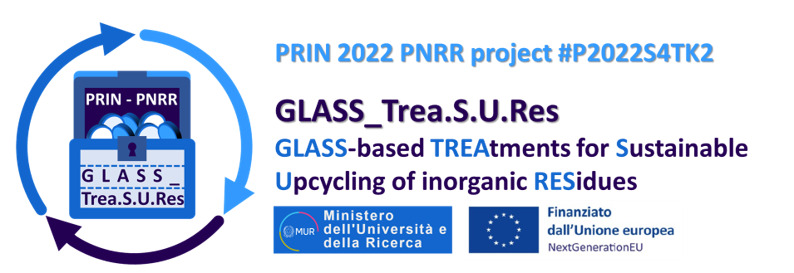Deliverables WP1
DELIVERABLE 1.1: ‘Report on chemical composition, mineralogy, chemical stability, impact of waste glasses’
In agreement with the objectives of WP1: ‘Material Selection’, the following glasses waste sensitive to weak alkali activation (not exceeding 3M) were identified and characterized: pharmaceutical boro-alumino-silicate glass (having different degrees of contaminations from other materials), Opal glass, LCD glass at Unipd and WEEE glasses (Waste from Electrical and Electronic Equipment like glasses from dismissed photovoltaic plants and fluorescent lamps) at UniMORE. All these glasses have been ground into fine powders and activated by addition of alkaline solution. The resulting slurries were dried through cold consolidation (40-75°C) combined with microwave heating. The hardened monoliths are boiling resistant and have density and compression strength characteristics that make them competitive with many building materials currently on the market such as concrete, bricks and cement.
The above-mentioned residues have undergone a systematic characterization, in terms of chemical composition and mineralogy, before and after activation. The alkaline environment of the solution results in the partial dissolution of the glass particles surface with consequent formation of a cross-linked structure featuring strong Si-O-Si, Si-O-Al and Al-O-Al bonds [1,2]. All glass components in solution form secondary phases, also by interaction with atmosphere (formation of carbonate and hydrate carbonate). Immersion of weak alkali activated samples in boiling water removes carbonates and secondary soluble phases but leaves the bonds between particle surfaces intact.
The application of microwave heating in combination with low temperature drying in the oven has allowed to considerably reduce curing times and energy consumption which is of considerable interest in the perspective of industrial exploitation [3]. It is generally agreed that MW heating is more efficient, prevents the formation of temperature gradients through volumetric heating of the material and, above all, requires less energy compared to other processes [3,4]. In the case of BASG and Opal glass, the microwave treatment also improved the strength of the consolidated material while leaving the density virtually unchanged.
Selection has aimed at separating ‘active’ from ‘passive’ supplementary residues, according to the reactivity, in turn due to granulometry and/or chemical composition and/or mineralogy. The addition of fine particles (below 75 μm) of Al2O3-rich residues such as volcanic ashes (pumice and lapillus) has considerably increased the stability and the mechanical properties of the final product [5]. The development of new glass-based formulations implementing fine pumice and lapillus tailings as matrix components was in accordance with the task M1.2: Identification of combinations of supplementary inorganic residues and glasses forming stable gels of WP1.
The release of pollutants and glass components into solution has been investigated by leaching tests conducted on activated materials. The detection of specific elements (such as metals and Ba in the case of BASG) is closely related to the stability of the gel phase formed between glass particles during activation process. This phenomenon was considerably reduced by subjecting the material to successive boiling and drying cycles.
Finally, infrared spectroscopy analisys, antimicrobial (gram positive and negative bacteria) and cytotoxicity (Keratinocytes HaCaT cells) studies conducted at UniCaLV on all materials produced supported leaching tests results. All compositions were found to have antimicrobial activity with differences depending on the alkaline activator (NaOH or KOH) and molarity. Non-cytotoxic formulations were selected for further investigation.
DELIVERABLE 1.2: ‘Report on chemical composition, mineralogy, chemical stability, impact of waste glasses supplementary inorganic residues’
The pursuit of milestone M1.2: Identification of combinations of supplementary inorganic residues and glasses forming stable gels led to the selection of two distinct aluminosilicates of volcanic origin, pumice and lapillus, meant to be implemented as a fine component of the activated formulations based on WEEE glass, substituting 10% of the solid fraction in weight. These materials, provided as extraction scraps from Italian volcanic quarries, are richer in alumina and poorer in alkali compared to the waste glasses, and despite their mineralogy being characterized by a more extensive crystalline component, mainly consisting of aluminosilicates such as sanidine and anorthite, their amorphous portion is substantial enough to be deemed of interest for reactivity in alkali environment [5-7].
The volcanic materials were finely ground to match the granulometry of the waste glasses, substituted to 10% of the weight of the glass powder, subjected to weak alkali activation, and finally to cold consolidation. The resulting hardened samples proved stable upon both prolonged immersion in distilled water and boiling, maintaining structural integrity with limited ions release and loss of bulk mass.
The difference in amorphous fraction between the volcanic materials (80% for pumice, 16% for lapillus [6]) appeared to influence their response to activation, given that pumice integration lead to formation of more cohesive monoliths, less subject to surface cracking and/or disintegration upon boiling, when compared to ones integrated with lapillus and developed according to the same parameters.
Pumice and lapillus addition appeared to significantly affect the cytotoxicity of the formulations, leading to a general decreased inhibition of HaCaT cells viability compared to samples developed exclusively from WEEE glass. This phenomenon could be seen as a mitigation effect determined by the lower concentration of alkali and heavy metals within the volcanic precursors when compared to the WEEE glass that they partially replace in the matrix, leading to a decreased impact of such leached components on cell culture proliferation.
References
[1] M. Mahmoud, J. Kraxner, A. Mehta, H. Elsayed, D. Galusek, E. Bernardo, Alkali activation-induced cold consolidation of waste glass: Application in organic-free direct ink writing of photocatalytic dye destructors, Journal of the European Ceramic Society 44 (9) (2023), https://doi.org/10.1016/j.jeurceramsoc.2023.12.023.
[2] G. Tameni, F. Cammelli, H. Elsayed, F. Stangherlin, E. Bernardo, Upcycling of boro-alumino-silicate pharmaceutical glass in sustainable construction materials, Detritus 20 (2022), 10.31025/2611-4135/2022.15218.
[3] J. Aschoff, S. Partschefeld, J. Schneider, A. Osburg, Effect of Microwaves on the Rapid Curing of Metakaolin and Aluminum Orthophosphate-Based Geopolymers. Materials 17 (463) (2024), https://doi.org/10.3390/ma17020463.
[4] B. Horvat, M. Pavlin, V. Ducman, Influence of microwaves in the early stage of alkali activation on the mechanical strength of alkali-activated materials,Ceramics International 49 (14) (2023), https://doi.org/10.1016/j.ceramint.2022.12.133.
[5] F. Altimari, I. Lancellotti, C. Leonelli, F. Andreola, H. Elsayed, E. Bernardo, L. Barbieri, Green materials for construction industry from Italian volcanic quarry scraps, Materials Letters 333 (2023), https://doi.org/10.1016/j.matlet.2022.133615.
[6] L. Barbieri, F. Altimari, F. Andreola, B. Maggi, I. Lancellotti. Characterization of Volcano-Sedimentary Rocks and Related Scraps for Design of Sustainable Materials, Materials 16 (2023), https://doi.org/10.3390/ma16093408.
[7] G. Dal Poggetto, P. Douwe, A. Stroscio, E. Kamseu, I. Lancellotti, A. Elimbi, C. Leonelli, Dissolution of Volcanic Ash in Alkaline Environment for Cold Consolidation of Inorganic Binders, Materials 17 (2024), https://doi.org/10.3390/ma17205068.

